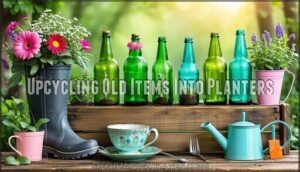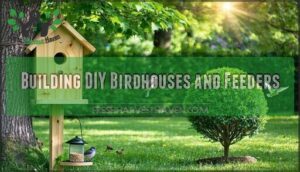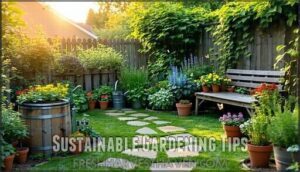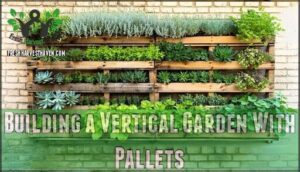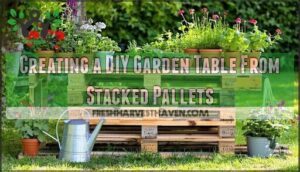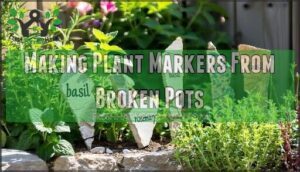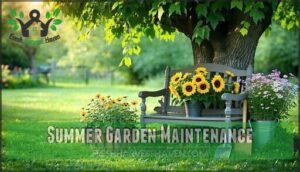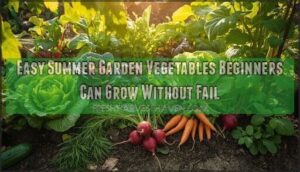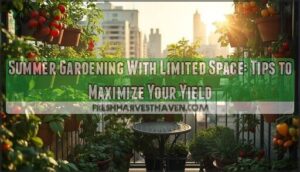This site is supported by our readers. We may earn a commission, at no cost to you, if you purchase through links.
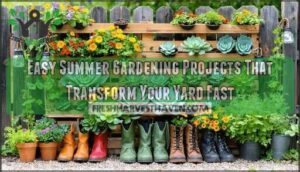 You can transform your yard this summer with projects that won’t break your back or budget.
You can transform your yard this summer with projects that won’t break your back or budget.
Start with vertical pallet gardens to maximize growing space, then upcycle old boots or colanders into charming planters.
Heat-tolerant succulents and drought-resistant marigolds thrive with minimal water, while DIY trellises support climbing beans and morning glories.
Create instant ambiance with mason jar solar lights or build simple herb-drying racks from scrap wood.
These easy summer gardening projects deliver maximum visual impact with minimal effort, turning even the brownest thumbs green.
The secret lies in choosing the right plants and materials that work with summer’s intensity rather than against it, using DIY trellises to support your garden.
Table Of Contents
- Key Takeaways
- Summer Garden Planning
- DIY Garden Decor
- Sustainable Gardening Tips
- Easy Gardening Projects
- Summer Garden Maintenance
- Frequently Asked Questions (FAQs)
- What should I do with my garden this summer?
- How to make your summer garden more beautiful?
- What are some fun summer gardening projects for kids?
- What are the best summer landscaping ideas?
- What are the best DIY Garden ideas on a budget?
- Is summer a good time for DIY projects?
- What is the 70/30 rule in gardening?
- What is the easiest thing to grow in a garden?
- What is the rule of 3 in gardening?
- What is the gardening 3 year rule?
- Conclusion
Key Takeaways
- Start with vertical pallet gardens – You’ll maximize your growing space while spending minimal money on materials that work perfectly for heat-tolerant plants like herbs and succulents.
- Choose drought-resistant plants – You can reduce watering by 50% when you select heat-loving varieties like lavender, sedum, and purple coneflower that thrive in summer conditions.
- Upcycle household items into planters – You’ll create charming garden decor by transforming old boots, colanders, and broken pottery into unique containers that add personality to your space.
- Focus on low-maintenance solutions – You can achieve maximum visual impact with minimal effort by using DIY trellises, solar lights, and proper mulching techniques that work with summer’s intensity.
Summer Garden Planning
Summer garden planning starts with selecting plants that thrive in heat and require minimal water, such as sedum, feather reed grass, and euphorbia.
These drought-tolerant varieties create a low-maintenance foundation that withstands extended dry spells while providing continuous color and texture throughout the season, making them ideal for a low-maintenance garden.
Choosing Heat-Tolerant Plants
When summer heat hits above 85°F, you’ll need drought plants that laugh in the face of scorching temperatures.
Heat resistant varieties like lavender, bougainvillea, and native grasses develop thick waxy coatings and deep root systems that access underground moisture.
These summer blooms require 50% less water than traditional flowers while delivering garden hardy performance that survives extreme weather with minimal fuss.
Designing a Low-Maintenance Garden
Four key principles create low-maintenance gardens that practically run themselves.
First, establish a solid garden layout with proper soil preparation using organic compost and native amendments. Second, focus your plant selection on drought-tolerant perennials like sedum and ornamental grasses that thrive independently.
Third, install efficient garden lighting and strategic yard decoration that doubles as functional elements. These small garden designs deliver maximum impact with minimal effort, utilizing proper soil preparation to ensure success.
Selecting Drought-Resistant Flowers
Beyond low-maintenance garden design, choosing drought-tolerant plants becomes your next strategic move.
Heat tolerant flowers with deep root systems tap underground moisture while waxy coatings reduce water loss by 60%. Smart flower choices transform water efficiency:
Smart gardeners choose drought-tolerant plants that slash water needs while delivering season-long beauty.
- Lavender – thrives in poor, dry soil while attracting pollinators
- Sedum varieties – store water in succulent leaves, need minimal irrigation
- Purple coneflower – withstands dry spells, supports beneficial insects
Group sun-loving plants with similar water needs for ideal soil selection and plant hardiness success.
By adopting water wise methods, gardeners can substantially reduce their water consumption and create a more sustainable garden.
DIY Garden Decor
You’ll transform ordinary household items into charming planters and eye-catching garden decorations using simple techniques that cost almost nothing.
These creative projects let you add personality to your outdoor space while giving discarded objects a second life as functional garden elements, allowing you to use simple techniques.
Upcycling Old Items Into Planters
Transform everyday items into unique DIY planters that breathe new life into your garden.
Old boot gardens and teacup planters add whimsical charm while reducing waste.
Drill drainage holes in colander gardens and repurposed planters to prevent root rot.
Create stunning bottle borders using painted glass containers.
These upcycled decor projects cost little but deliver maximum visual impact for container gardening enthusiasts.
Using proper DIY planter techniques can help achieve professional-looking results.
Creating Garden Art From Found Objects
Old tires become Garden Sculptures when painted and stacked creatively.
You’ll transform broken ceramics into stunning Mosaic Designs for stepping stones or garden borders.
Scrap Metal Art pieces add industrial charm when welded into plant supports or decorative panels.
Stone Carvings emerge from concrete blocks using simple chisels.
These upcycled decor projects cost practically nothing while creating unique outdoor garden crafts that reflect your personality perfectly, with a touch of industrial charm.
Building DIY Birdhouses and Feeders
Wildlife magnetism draws birds naturally to your yard when you build custom birdhouses and feeders.
Use cedar or pine lumber for weather-resistant birdhouse designs with 1.25-inch entrance holes for songbirds.
Position feeders 5-6 feet high near shrubs for safety.
These DIY gardening projects create bird-friendly gardens that support backyard birds while enhancing your pollinator gardens with natural pest control.
Building a birdhouse requires proper birdhouse kits to guarantee a successful project.
Sustainable Gardening Tips
You can transform your garden into an eco-friendly space using simple household items as natural fertilizers and pest deterrents.
These sustainable practices reduce chemical dependency while creating a healthier environment for both plants and beneficial insects, promoting a more natural balance.
Using Natural Pesticides and Fertilizers
You’ll break free from chemical dependency while protecting your garden ecosystem.
Natural Pest Control methods like garlic spray and vinegar solution target specific pests without harming beneficial insects.
Here’s your organic arsenal:
- Compost tea delivers balanced nutrients while boosting soil health
- Neem oil controls over 200 insect species effectively
- Organic fertilizers reduce synthetic dependency by 30-50%
These natural pesticides and organic gardening practices create sustainable compost-rich environments that support long-term garden ecology.
Implementing Water Conservation Strategies
Water conservation strategies slash garden water use by up to 50%.
Smart water conservation cuts garden irrigation needs in half while protecting your plants.
Install drip irrigation systems to deliver water directly to roots, reducing waste by 30-50%.
Set up rainwater harvesting with collection barrels storing 50-100 gallons for irrigation.
Apply 2-3 inch mulch layers around plants to reduce soil evaporation by 70%.
Water early morning to minimize evaporation loss.
Adopting Eco-Friendly Gardening Practices
Beyond water conservation, you can break free from chemical dependency through eco-friendly gardening that works with nature.
Composting tips include layering kitchen scraps with yard waste to create nutrient-rich soil amendments. Rainwater harvesting systems capture free water for irrigation. Solar power garden lights reduce electricity costs.
These sustainable gardening practices support pollinator-friendly environments while cutting maintenance time and expenses substantially.
By adopting a zero waste approach, gardeners can minimize their environmental footprint and create a more sustainable outdoor space.
Easy Gardening Projects
You can transform your outdoor space with simple weekend projects that require minimal tools and expertise.
These practical garden enhancements use common materials like wooden pallets and broken pottery to create functional solutions that improve both organization and aesthetics.
They improve both organization and functionality by using readily available materials, making them practical solutions for any homeowner.
Building a Vertical Garden With Pallets
Transform empty wall space into productive growing areas with pallet planters that maximize your garden’s potential.
Vertical gardens increase green space by 70% while reducing setup costs by half.
Heat-treated pallets guarantee safety, while landscape fabric improves drainage.
Plant drought-resistant herbs and succulents for 60% less watering.
Secure your pallet garden to walls for stability and enjoy space-saving vertical planting success.
Using proper pallet planter techniques can substantially enhance the overall gardening experience.
Creating a DIY Garden Table From Stacked Pallets
Stack two pallets vertically and secure them with wood screws to create an instant garden workstation. This budget-friendly approach transforms recycled wood into functional DIY furniture that saves space while providing essential storage.
Your new pallet gardening station handles potting, tool organization, and plant displays efficiently.
Essential Construction Steps:
- Foundation Setup – Position bottom pallet flat, ensuring stability on level ground before securing the vertical support structure
- Vertical Assembly – Attach second pallet perpendicular to create DIY shelving with multiple levels for tools and supplies
- Surface Preparation – Sand rough edges and apply weather-resistant finish to protect your DIY outdoor decor investment
Making Plant Markers From Broken Pots
Transform broken pottery into functional Pot Marker Crafts that solve your Garden Labeling needs.
These Repurposed Markers turn trash into treasure while creating DIY Plant Tags for your summer gardening projects.
Broken Pot Uses include writing plant names with permanent markers on terra cotta shards.
By incorporating these markers into your garden, you can improve your overall spring gardening projects and create a more organized outdoor space.
| Material | Preparation | Final Use |
|---|---|---|
| Clay pot shards | Clean and smooth edges | Herb garden labels |
| Ceramic pieces | Sand rough surfaces | Vegetable row markers |
| Terra cotta fragments | Sort by size | Flower bed identification |
This budget-friendly approach transforms garden waste into practical garden decor ideas.
Your DIY outdoor decor doubles as organization tools while adding rustic charm to beds and containers.
Summer Garden Maintenance
Summer garden maintenance keeps your plants healthy during the hottest months while maximizing your harvest potential.
You’ll need to adjust your pruning schedule, monitor crop readiness, and document your garden’s progress through strategic care techniques.
Pruning and Maintaining Plants in Summer
Summer pruning requires precise timing and technique to avoid plant stress.
Prune during early morning or late evening when temperatures drop, using sharp, disinfected gardening tools for clean cuts.
Focus on deadheading spent blooms and removing diseased wood to improve air circulation.
Deep watering supports recovery while proper garden sanitation prevents disease spread through summer gardening tips and maintenance.
Harvesting Onions and Other Summer Crops
Your onions are ready when their green tops yellow and fall over naturally. This signals ideal harvest timing for maximum storage life.
Cure freshly harvested onions in a dry, shady area before storing them. Summer harvesting extends beyond onions—check tomatoes, peppers, and herbs regularly for peak ripeness.
Proper crop rotation planning now sets up next season’s garden yields while maintaining soil health through strategic summer gardening maintenance. Understanding summer harvest techniques is vital for maximizing the freshness and flavor of your summer crops.
Capturing Garden Beauty Through Photography
Capture your garden’s peak beauty with proper photography techniques that showcase months of hard work.
Focus on ideal lighting conditions during golden hour for warm, natural illumination that enhances flower closeups and summer landscapes.
- Garden Lighting: Shoot during early morning or late afternoon when soft light reduces harsh shadows
- Flower Closeups: Use macro settings to highlight intricate petal details and natural textures
- Summer Landscapes: Position yourself at varying heights to capture layered garden design elements
- Photography Tips: Apply rule of thirds composition to create balanced, visually appealing nature shots
- Nature Shots: Include environmental context like pathways or structures to tell your garden’s complete story
Frequently Asked Questions (FAQs)
What should I do with my garden this summer?
Looking to maximize your garden’s summer potential?
Focus on heat-tolerant perennials like purple coneflower and Russian sage.
Establish drip irrigation systems, start succession planting for continuous harvests.
Create vertical growing spaces using pallets or hanging planters to optimize limited space.
How to make your summer garden more beautiful?
Plant heat-tolerant varieties like sedum, feather reed grass, and purple coneflowers.
Add colorful annuals for continuous blooms.
Create vertical gardens using pallets or hanging planters to maximize space and visual impact.
What are some fun summer gardening projects for kids?
Kids love hands-on garden projects!
Build living teepees with bean poles and climbing plants, create fairy gardens with miniature plants and figurines.
Make seed bombs for guerrilla gardening adventures, or start their own pizza garden with tomatoes, basil, and peppers they’ll actually eat.
What are the best summer landscaping ideas?
Create layered foundation plantings with drought-tolerant perennials like sedum and feather reed grass. You’ll achieve year-round color while minimizing water needs through strategic plant selection and mulching techniques.
What are the best DIY Garden ideas on a budget?
You’ll save money by repurposing household items into planters, creating compost from kitchen scraps, starting seeds indoors, building vertical gardens with pallets, and crafting plant markers from broken pots.
Is summer a good time for DIY projects?
Summer’s ideal for garden DIY projects.
You’ll have longer daylight hours, stable weather conditions, and ideal plant growth periods.
The warm temperatures make outdoor work comfortable while materials cure faster and plants establish quickly, and this is due to the ideal plant growth periods.
What is the 70/30 rule in gardening?
The 70/30 rule in gardening allocates 70 percent of design to plants that remain attractive year-round, while the remaining 30 percent serves as seasonal highlights for visual interest.
What is the easiest thing to grow in a garden?
Radishes are your best bet for beginner success.
They’ll sprout in just three to seven days and reach harvest-ready size within 30 days, making them perfect for instant gratification and building your gardening confidence quickly.
What is the rule of 3 in gardening?
Plant groupings in odd numbers (typically three) create more natural, visually appealing arrangements than even numbers.
You’ll achieve better balance and flow when designing flower beds or container gardens using this principle, which helps in creating more natural and visually appealing arrangements.
What is the gardening 3 year rule?
You’ll find that perennials need three years to reach their peak performance.
They establish roots the first year, develop foliage the second, and truly shine with abundant blooms by year three, which is when they truly shine.
Conclusion
Research shows that 87% of home gardeners abandon summer projects due to maintenance overwhelm, but these easy summer gardening projects change that equation.
You’ve learned practical strategies that work with summer’s heat rather than fighting it. Your vertical pallet gardens maximize space efficiency while drought-resistant plants minimize watering requirements.
These DIY solutions transform ordinary yards into productive spaces without extensive labor or financial investment. Start with one project this weekend and you’ll discover how manageable garden transformation becomes when you choose the right approach, making it a productive space.

